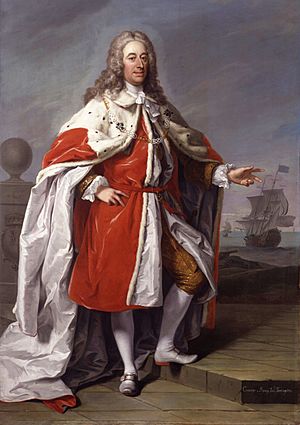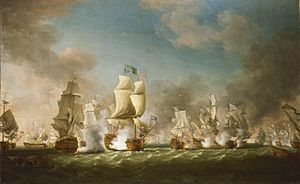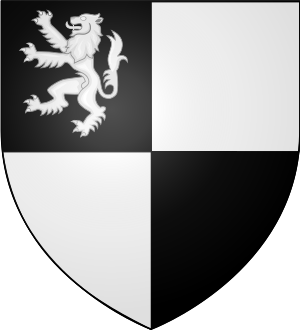George Byng, 1st Viscount Torrington facts for kids
Quick facts for kids
The Viscount Torrington
|
|
|---|---|

Admiral of the Fleet George Byng, 1st Viscount Torrington by Jeremiah Davison in 1733
|
|
| Born | 27 January 1663 Wrotham, Kent |
| Died | 17 January 1733 (aged 69) Southill, Bedfordshire |
| Buried |
Church of All Saints, Southill, Bedfordshire
|
| Allegiance | |
| Service/ |
|
| Years of service | 1678–1733 |
| Rank | Admiral of the Fleet |
| Commands held | HMS Constant Warwick HMS Hope HMS Duchess HMS Royal Oak HMS Britannia HMS Nassau Mediterranean Fleet |
| Battles/wars | Glorious Revolution Nine Years' War |
| Awards | Knight Companion of the Order of the Bath |
George Byng, 1st Viscount Torrington (born January 27, 1663 – died January 17, 1733) was an important officer in the Royal Navy and a statesman. He is known for his role in the Glorious Revolution and for leading the British fleet to victory in the Battle of Cape Passaro. He later became the head of the Admiralty, which was in charge of the Royal Navy.
Contents
George Byng began his naval career in May 1678 as a "King's Letter Boy." This was a special way for young men to join the Royal Navy. He served on several ships, learning the ropes of naval life.
In 1680, he sailed to Tangier and even spent a short time serving in the army there. He returned to the navy as a lieutenant in 1684. One of his early missions took him to the East Indies to help stop a rebellion in Bombay.
A Key Moment in History
A very important event happened in October 1688. Byng, still a lieutenant, delivered a secret letter to Prince William of Orange. The Prince had just arrived in England, and the letter showed that many navy captains supported him. Byng's actions helped the Royal Navy switch its loyalty to Prince William. This was a crucial moment in the Glorious Revolution, which changed who ruled England.
Soon after, in December 1688, Byng was promoted to captain. He commanded several ships and fought in the Battle of Beachy Head in July 1690 during the Nine Years' War. He later became the Flag Captain for Admiral Edward Russell, commanding the impressive HMS Britannia.
In 1702, Byng commanded the HMS Nassau and took part in the Battle of Vigo Bay. In this battle, the French fleet was defeated during the War of the Spanish Succession.
Rising Through the Ranks
In March 1703, Byng was promoted to rear admiral. He became the third-in-command of the Mediterranean Fleet. He played a key role in the Capture of Gibraltar in August 1704, leading the ships that bombarded the area. He also fought in the Battle of Málaga later that month.
Byng was knighted in October 1704, becoming "Sir George Byng." He was promoted to vice admiral in January 1705 and became a Member of Parliament for Plymouth.
Challenges and Disasters
In 1707, Byng took part in the British defeat at the Battle of Toulon. Later that year, he was present during a terrible naval disaster off the Isles of Scilly. Four ships, including Admiral Cloudesley Shovell's flagship, were lost, and nearly 2,000 sailors died. Byng's own ship, HMS Royal Anne, survived.
In January 1708, Byng was promoted to full admiral. He became the Commander-in-Chief of the Mediterranean Fleet in 1709. He also joined the Board of Admiralty, which managed the Royal Navy. By October 1710, he became the Senior Naval Lord on the Admiralty Board.
Victory at Cape Passaro

Byng was promoted to Admiral of the Fleet in March 1718. He was sent to the Mediterranean to stop Spain from taking over Sicily. He found the Spanish fleet near Naples and chased them. In a clever move, he sent his fastest ships ahead, causing the Spanish fleet to split up.
On August 11, 1718, the two fleets clashed in the Battle of Cape Passaro. It was a huge victory for the British. The Spanish fleet was almost completely destroyed:
- 10 Spanish ships were captured.
- 4 Spanish ships were sunk or burned.
- 4 Spanish frigates (smaller warships) were captured.
This battle was a critical moment in the War of the Quadruple Alliance.
Later Career and Honors
After his great victory, Byng was given the power to negotiate with different leaders in Italy on behalf of the English crown. When he returned to England, he received more important roles. In October 1720, he became the Treasurer of the Navy and Rear-Admiral of Great Britain.
In September 1721, he was given the title of Baron Byng of Southill and the 1st Viscount Torrington. This meant he was now a nobleman. He also developed his home, Southill Park in Bedfordshire.
In August 1727, Byng was appointed First Lord of the Admiralty. This was the highest position in the Royal Navy. In this role, he helped establish the Royal Naval College at Portsmouth, which trained future naval officers.
Family Life
George Byng married Margaret Master in March 1691. They had a large family with fifteen children, though only six lived to adulthood. Some of his notable children included:
- Pattee Byng (1699–1747), who became the 2nd Viscount Torrington after his father.
- George Byng (1701–1750), who became the 3rd Viscount Torrington.
- Robert Byng (1703–1740), who served as the Governor of Barbados.
- John Byng (1704–1757), who also became an Admiral.
Death
George Byng died on January 17, 1733. He was buried in a special family tomb, called the Byng Mausoleum, at the Church of All Saints in Southill.





